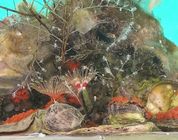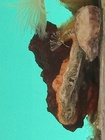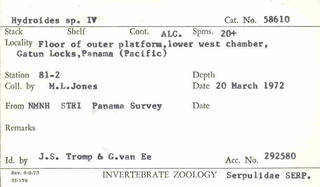
| About | | Search taxa | | Taxon tree | | Search literature | | Specimens | | Distribution | | Checklist | | Stats | | Log in |
CaRMS taxon detailsHydroides Gunnerus, 1768
129566 (urn:lsid:marinespecies.org:taxname:129566)
accepted
Genus
marine,
recent only
Gunnerus, J. E. (1768). Om Nogle Norske Coraller. <em>Det Kongelige Norske Videnskabers Selskabs Skrifter.</em> 4: 38-73., available online at http://gdz.sub.uni-goettingen.de/dms/load/img/?PPN=PPN481641912_0004&IDDOC=273812
page(s): 52 [details]
Note Type species: Hydroides norvegica Gunnerus,...
From editor or global species database
Type species Type species: Hydroides norvegica Gunnerus, 1768 in Fauchald (1977). [details]
Etymology Moen (2006) states: "The name Hydra, and the later Hydroides, seem to refer to the many-headed aquatic snake that was slain...
Etymology Moen (2006) states: "The name Hydra, and the later Hydroides, seem to refer to the many-headed aquatic snake that was slain by Hercules in Greek mythology. But more specifically, it refers to the resemblance to the cnidarian genus described by Linnæus in 1758". Elsewhere, Stearn 1983:266) in his "Botanical Latin" explains that '-oides' endings were commonly used before and during Linnæus's era to indicate a resemblance to a genus already known, although Linnaeus himself disliked the practice as an easy option, and his disciples at times used '-oides' names as provisional. [details] Nomenclature The genus Hydroides is feminine. This is because Gunnerus clearly treated it as feminine when he used the feminine...
Nomenclature The genus Hydroides is feminine. This is because Gunnerus clearly treated it as feminine when he used the feminine 'norvegica' as epithet instead of the masculine 'norvegicus'. The AnimalBase record [has link to the digitized work] extracted from the original states this explicitly. For a long period, the ICZN, from at least the 2nd Edition (1964: Art. 30a(ii), required (via the examples) that genus names ending in -oides are to be treated as masculine. In the ICZN 3rd Edition (1985: Art. 30b) the text was the same (the examples text stated that these genus names were 'substantivated adjectives'). Despite this requirement, mostly taxonomists working on Hydroides during this period treated it as feminine. A modification with a major effect on Hydroides names occurred in 1999 with the publication of a new Code edition. In the ICZN 4th Edition (1999: Art. 30.1.4.4) a qualifying clause was added that had the effect of reverting the gender of Hydroides to its original feminine status. The wording in full is "A compound genus-group name ending in the suffix -ites, -oides, -ides, -odes, or -istes is to be treated as masculine unless its author, when establishing the name, stated that it had another gender or treated it as such by combining it with an adjectival species-group name in another gender form." Consequently the history is that for about 35 years species names in Hydroides were required to have masculine endings according to the Code, and now for the last 15 years they are required to have feminine endings again. In practice taxonomists' only widely adopted the masculine form around 1992 (fide Moen, 2006:121). As stated this became incorrect from 1999. The change in the Code was part of changes intended "to simplify the identification of gender in genus-group names" (ICZN, 1999:XXVI). However, in a large genus such as Hydroides many changes may result, and each name requires re-evaluation. [details]
CaRMS (2025). Hydroides Gunnerus, 1768. Accessed at: https://www.marinespecies.org/carms/aphia.php?p=taxdetails&id=129566 on 2025-05-02
Nozères, C., Kennedy, M.K. (Eds.) (2025). Canadian Register of Marine Species. Hydroides Gunnerus, 1768. Accessed at: https://www.marinespecies.org/CaRMS/aphia.php?p=taxdetails&id=129566 on 2025-05-02
Date action by
original description
Gunnerus, J. E. (1768). Om Nogle Norske Coraller. <em>Det Kongelige Norske Videnskabers Selskabs Skrifter.</em> 4: 38-73., available online at http://gdz.sub.uni-goettingen.de/dms/load/img/?PPN=PPN481641912_0004&IDDOC=273812
page(s): 52 [details] basis of record Kupriyanova, E.; Sun, Y.; Wong, E.; Ten Hove, H. (2023). Hydroides of the World. , available online at https://doi.org/10.1071/9781486311590 [details] additional source Read, Geoffrey B.; Ten Hove, Harry A.; Sun, Yanan; Kupriyanova, Elena K. (2017). Hydroides Gunnerus, 1768 (Annelida, Serpulidae) is feminine: a nomenclatural checklist of updated names. <em>ZooKeys.</em> 642: 1-52., available online at http://zookeys.pensoft.net/articles.php?id=10443 note: checklist, etymology, type localities [details] Available for editors additional source Hove, Harry A. ten.; Kupriyanova, Elena K. (2009). Taxonomy of Serpulidae (Annelida, Polychaeta): The state of affairs. <em>Zootaxa.</em> 2036: 1-126., available online at http://www.mapress.com/j/zt/issue/view/2173 page(s): 52 [details] additional source Glasby, Christopher J.; Read, Geoffrey B.; Lee, Kenneth E.; Blakemore, R.J.; Fraser, P.M.; Pinder, A.M.; Erséus, C.; Moser, W.E.; Burreson, E.M.; Govedich, F.R.; Davies, R.W.; Dawson, E.W. (2009). Phylum Annelida: bristleworms, earthworms, leeches. <em>[Book chapter].</em> Chapt 17, pp. 312-358. in: Gordon, D.P. (Ed.) (2009). New Zealand inventory of biodiversity: 1. Kingdom Animalia: Radiata, Lophotrochozoa, Deuterostomia. Canterbury University Press, Christchurch. [details] Available for editors additional source Moen, Toril Loennechen. (2006). A translation of Bishop Gunnerus' description of the species Hydroides norvegicus [sic] with comments on his Serpula triqvetra. <em>Scientia Marina.</em> 70 (Supplement 3):115-123., available online at http://www.icm.csic.es/scimar/index.php/secId/7/IdArt/167/ note: history of the genus name [details] additional source Fauchald, K. (1977). The polychaete worms, definitions and keys to the orders, families and genera. <em>Natural History Museum of Los Angeles County: Los Angeles, CA (USA), Science Series.</em> 28:1-188., available online at http://www.vliz.be/imisdocs/publications/123110.pdf [details] additional source Bellan, G. (2001). Polychaeta, <i>in</i>: Costello, M.J. <i>et al.</i> (Ed.) (2001). European register of marine species: a check-list of the marine species in Europe and a bibliography of guides to their identification. <em>Collection Patrimoines Naturels.</em> 50: 214-231. (look up in IMIS) [details] additional source Bastida-Zavala, Jose Rolando and ten Hove, Harry A. 2002. Revision of Hydroides Gunnerus, 1768 (Polychaeta: Serpulidae) from the Western Atlantic Region. Beaufortia, 52(9): 103-178. [details] additional source Bastida-Zavala, José Rolando; ten Hove, Harry A. (2003). Revision of <i>Hydroides</i> Gunnerus, 1768 (Polychaeta: Serpulidae) from the Eastern Pacific Region and Hawaii. <em>Beaufortia.</em> 53(4): 67-110., available online at http://www.repository.naturalis.nl/record/505009 [details] Available for editors identification resource Sun, Yanan; Wong, Eunice; ten Hove, Harry A.; Hutchings, Pat A.; Williamson, Jane E.; Kupriyanova, Elena. (2015). Revision of the genus <em>Hydroides </em>(Annelida: Serpulidae) from Australia. <em>Zootaxa.</em> 4009(1): 1-99., available online at https://doi.org/10.11646/zootaxa.4009.1.1 [details] identification resource Sun, Ruiping; Yang, Dejian. (2014). Annelida Polychaeta III Sabellida. <em>Fauna Sinica Invertebrata.</em> 54: 1-493., available online at http://www.hceis.com/home/book_view.aspx?id=12616&ISBN=9787030419217&EnName=Fauna+Sinica+Invertebrata++Vol.54+Annelida+Polychaeta+III++Sabellida page(s): 452; note: Key in English to 32 species of Hydroides occurring in Chinese waters [details]  Present Present  Inaccurate Inaccurate  Introduced: alien Introduced: alien  Containing type locality Containing type locality
From editor or global species database
Etymology Moen (2006) states: "The name Hydra, and the later Hydroides, seem to refer to the many-headed aquatic snake that was slain by Hercules in Greek mythology. But more specifically, it refers to the resemblance to the cnidarian genus described by Linnæus in 1758". Elsewhere, Stearn 1983:266) in his "Botanical Latin" explains that '-oides' endings were commonly used before and during Linnæus's era to indicate a resemblance to a genus already known, although Linnaeus himself disliked the practice as an easy option, and his disciples at times used '-oides' names as provisional. [details]Grammatical gender Feminine fide Gunnerus (1768) and 1999 ICZN Code, Art. 30.1.4.4) [details] Nomenclature The genus Hydroides is feminine. This is because Gunnerus clearly treated it as feminine when he used the feminine 'norvegica' as epithet instead of the masculine 'norvegicus'. The AnimalBase record [has link to the digitized work] extracted from the original states this explicitly. For a long period, the ICZN, from at least the 2nd Edition (1964: Art. 30a(ii), required (via the examples) that genus names ending in -oides are to be treated as masculine. In the ICZN 3rd Edition (1985: Art. 30b) the text was the same (the examples text stated that these genus names were 'substantivated adjectives'). Despite this requirement, mostly taxonomists working on Hydroides during this period treated it as feminine. A modification with a major effect on Hydroides names occurred in 1999 with the publication of a new Code edition. In the ICZN 4th Edition (1999: Art. 30.1.4.4) a qualifying clause was added that had the effect of reverting the gender of Hydroides to its original feminine status. The wording in full is "A compound genus-group name ending in the suffix -ites, -oides, -ides, -odes, or -istes is to be treated as masculine unless its author, when establishing the name, stated that it had another gender or treated it as such by combining it with an adjectival species-group name in another gender form." Consequently the history is that for about 35 years species names in Hydroides were required to have masculine endings according to the Code, and now for the last 15 years they are required to have feminine endings again. In practice taxonomists' only widely adopted the masculine form around 1992 (fide Moen, 2006:121). As stated this became incorrect from 1999. The change in the Code was part of changes intended "to simplify the identification of gender in genus-group names" (ICZN, 1999:XXVI). However, in a large genus such as Hydroides many changes may result, and each name requires re-evaluation. [details] Type species Type species: Hydroides norvegica Gunnerus, 1768 in Fauchald (1977). [details] |




